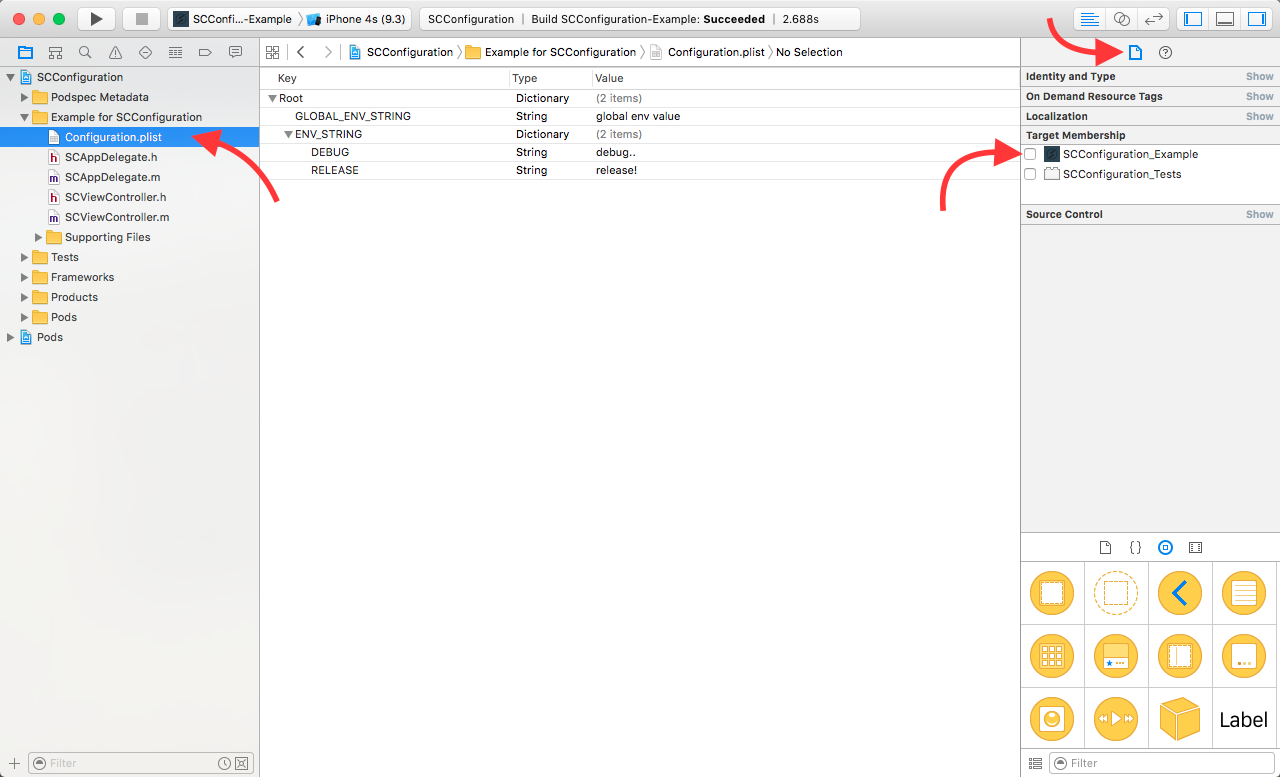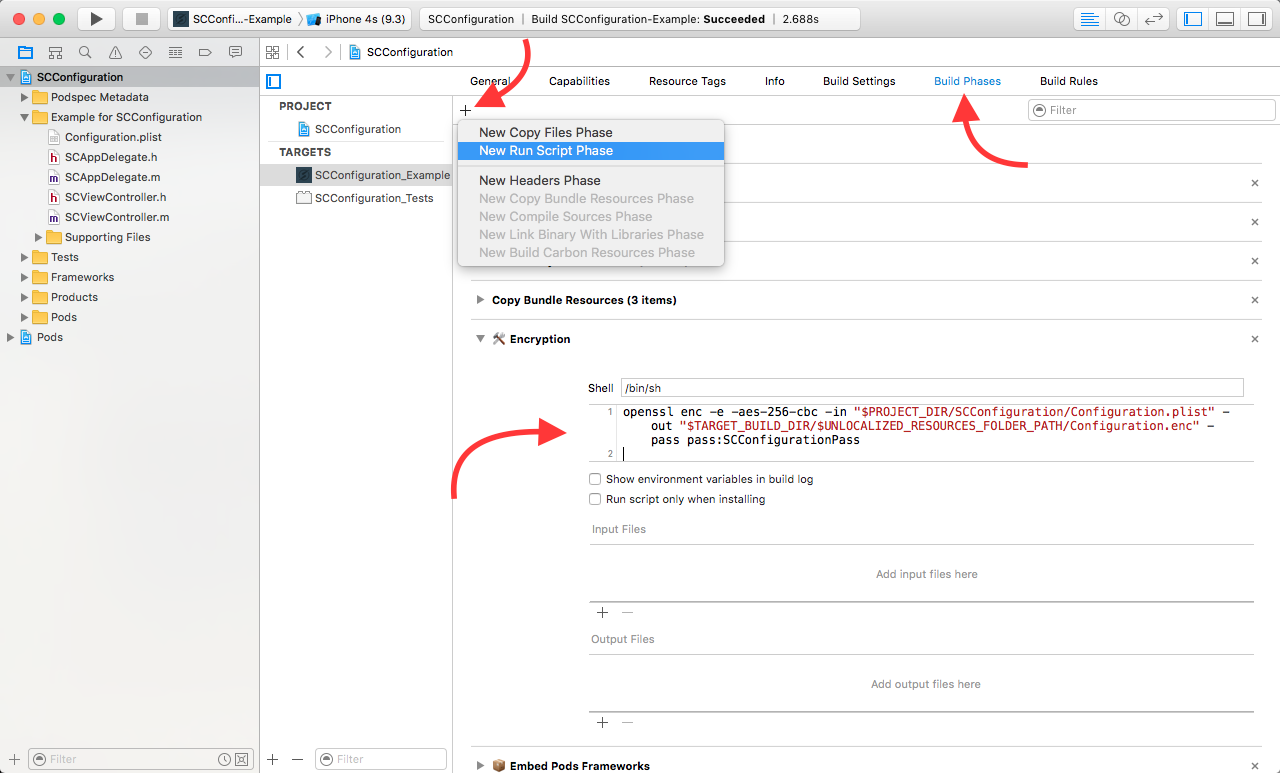SCConfiguration 2.2.0
| TestsTested | ✓ |
| LangLanguage | Obj-CObjective C |
| License | MIT |
| ReleasedLast Release | Jan 2018 |
Maintained by Gergő Németh, Dávid Horváth, Balazs Kovacs.
SCConfiguration 2.2.0
- By
- Supercharge
- TeamSupercharge
Made with ♥︎ at Supercharge
Introduction
With SCConfiguration you can easily manage environment dependent (or global) configuration parameters in a property list file.
Moreover, from version 1.1.0 you can encrypt your configuration file if it contains sensitive information.
Installation
SCConfiguration is available through CocoaPods. To install it, simply add the following line to your Podfile:
pod "SCConfiguration"Usage
Defining the parameters in the Configuration.plist file
First, you need to create a configuration file called Configuration.plist in your project.
You can add global or environment dependent key-value pairs to it, here's an example with STAGING and PRODUCTION environments.
In source format:
<dict>
<key>APPLE_APP_ID</key> <!-- global parameter -->
<string>123456789</string>
<key>API_URL</key> <!-- environment dependent parameter -->
<dict>
<key>STAGING</key>
<string>https://staging.myappserver.com</string>
<key>PRODUCTION</key>
<string>https://myappserver.com</string>
</dict>
</dict>Setting the environment and reading the parameters
If ENV is a preprocessor macro defined by the build configuration you can easily set the configuration class's environment in the application:didFinishLaunchingWithOptions: method:
SCConfiguration *configuration = [SCConfiguration new];
// Set the environment defined by the ENV preprocessor macro
[configuration setEnv:ENV];
// Read the API_URL environment dependent value from the configuration
NSString *apiUrl = [configuration configValueForKey:@"API_URL"]You can also use SCConfiguration as a singleton:
// Set the environment defined by the ENV preprocessor macro
[[SCConfiguration sharedInstance] setEnv:ENV];
// Read the API_URL environment dependent value from the configuration
NSString *apiUrl = [[SCConfiguration sharedInstance] configValueForKey:@"API_URL"]Encrypting your Configuration file
If you're using v1.1.0 or above, with a few additional steps you can encrypt your configuration file. This is very useful if the file contains sensitive information such as production API URLs, third party App IDs or client secrets.
The initial problem here is that by default your Configuration.plist file will be added to the .ipa file without encryption. If someone downloads your application from the App Store, unpacks the .ipa file and checks the app's contents, the Configuration file will be there as a plain XML file.
The solution is to remove the plist file from the build, add it as encrypted file with the help of a custom run script and use the SCConfiguration library to read the encrypted file.
Encryption steps:
1) select your Configuration.plist file in Xcode and UNCHECK the target membership in the Utilities plane / File inspector tab:
2) add a new custom Run Script to your project's Targets with the name Encryption and with the following content:
openssl enc -e -aes-256-cbc -in "$PROJECT_DIR/SCConfiguration/Configuration.plist" -out "$TARGET_BUILD_DIR/$UNLOCALIZED_RESOURCES_FOLDER_PATH/Configuration.enc" -pass pass:<your password here>
IMPORTANT: You need to replace the Configuration.plist file's path to mach your project's structure and also you should add your own password to this script.
3) you need to add an extra line to the application:didFinishLaunchingWithOptions: method:
[[SCConfiguration sharedInstance] setDecryptionPassword:@"<your password here>"];Subclassing SCConfiguration
It's a good practice to subclass SCConfiguration and declare your configuration parameters explicitly in your application.
// MyAppConfiguration.h
@interface MyAppConfiguration : SCConfiguration
- (NSString *)apiUrl;
@end// MyAppConfiguration.m
@interface MyAppConfiguration : SCConfiguration
- (NSString *)apiUrl
{
return (NSString *)[self configValueForKey:@"API_URL"];
}
@endOverriding configuration variables
You can override configuration variable at runtime. This can be useful if you would like to synchronize configuration parameters through a backend service.
You need to add the following line to the applicationDidEnterBackground: and applicationWillTerminate: methods:
[[SCConfiguration sharedInstance] tearDown];This method saves the configuration modifications between application launches.
You can overwrite / add key-value pairs:
NSDictionary *newConfigValues = @{ @"key1": @"new value", @"new key": @"new value" };
[[SCConfiguration sharedInstance] overwriteConfigWithDictionary:newConfigValues];NOTE: overwritten key-value pairs will stay between application launches by default! You can change this behaviour by calling the [[SCConfiguration sharedInstance] setOverwriteStateToPersistent:NO].
Or you can set key-value pairs to protected / unprotected:
[[SCConfiguration sharedInstance] setKeysToProtected:@[@"key2", @"key3"]];
[[SCConfiguration sharedInstance] setKeyToProtected:@"key4"];
[[SCConfiguration sharedInstance] removeAllKeyFromProtection];Protected values cannot be changed / added later.
Compatibility
iOS 6+
Contributing
Contributions are always welcome! (:
- Fork it ( http://github.com/team-supercharge/SCConfiguration/fork )
- Create your feature branch (
git checkout -b my-new-feature) - Commit your changes (
git commit -am 'Add some feature') - Push to the branch (
git push origin my-new-feature) - Create new Pull Request
License
SCConfiguration is available under the MIT license. See the LICENSE file for more info.


